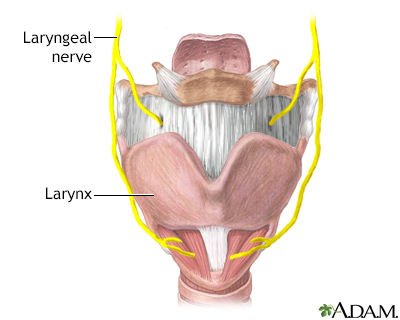Pregnancy SmartSiteTM
Vocal cord paralysis DefinitionLaryngeal nerve damage is injury to one or both of the nerves that cause the voice box to function. CausesInjury to the laryngeal nerves is uncommon. When it does occur, it can be from:
SymptomsSymptoms include:
Injury to the left and right laryngeal nerves at the same time can cause a breathing problem. This can be an urgent medical problem. Exams and TestsThe health care provider will check to see how your vocal cords move. Abnormal movement may mean that a laryngeal nerve is injured. Tests may include:
TreatmentTreatment depends on the cause of the injury. In some cases, no treatment may be needed and the nerve may recover on its own. Voice therapy is useful in some cases. If surgery is needed, the goal is to change the position of the paralyzed vocal cord to improve the voice. This can be done with:
If both the left and right nerves are damaged, a hole may need to be cut into the windpipe (tracheotomy) right away to allow breathing. This is followed by another surgery at a later date. Outlook (Prognosis)The outlook depends on the cause of the injury. In some cases, the nerve rapidly returns to normal. However, sometimes the damage is permanent. When to Contact a Medical ProfessionalContact your provider if you have:
ReferencesDexter EU. Perioperative care of the thoracic surgical patient. In: Sellke FW, del Nido PJ, Swanson SJ, eds. Sabiston and Spencer Surgery of the Chest. 9th ed. Philadelphia, PA: Elsevier; 2016:chap 4. Nouraei SAR, Sandhu GS. Laryngeal and esophageal trauma. In: Flint PW, Francis HW, Haughey BH, et al, eds. Cummings Otolaryngology: Head and Neck Surgery. 7th ed. Philadelphia, PA: Elsevier; 2021:chap 66. Woodson G. Pathophysiology of recurrent laryngeal nerve injury. In: Randolph GW, ed. Surgery of the Thyroid and Parathyroid Glands. 3rd ed. Philadelphia, PA: Elsevier; 2021:chap 42. | |
| |
Review Date: 11/29/2022 Reviewed By: Josef Shargorodsky, MD, MPH, Johns Hopkins University School of Medicine, Baltimore, MD. Also reviewed by David C. Dugdale, MD, Medical Director, Brenda Conaway, Editorial Director, and the A.D.A.M. Editorial team. The information provided herein should not be used during any medical emergency or for the diagnosis or treatment of any medical condition. A licensed medical professional should be consulted for diagnosis and treatment of any and all medical conditions. Links to other sites are provided for information only -- they do not constitute endorsements of those other sites. No warranty of any kind, either expressed or implied, is made as to the accuracy, reliability, timeliness, or correctness of any translations made by a third-party service of the information provided herein into any other language. © 1997- A.D.A.M., a business unit of Ebix, Inc. Any duplication or distribution of the information contained herein is strictly prohibited. | |

 Nerves of the lary...
Nerves of the lary... Laryngeal nerve da...
Laryngeal nerve da...
